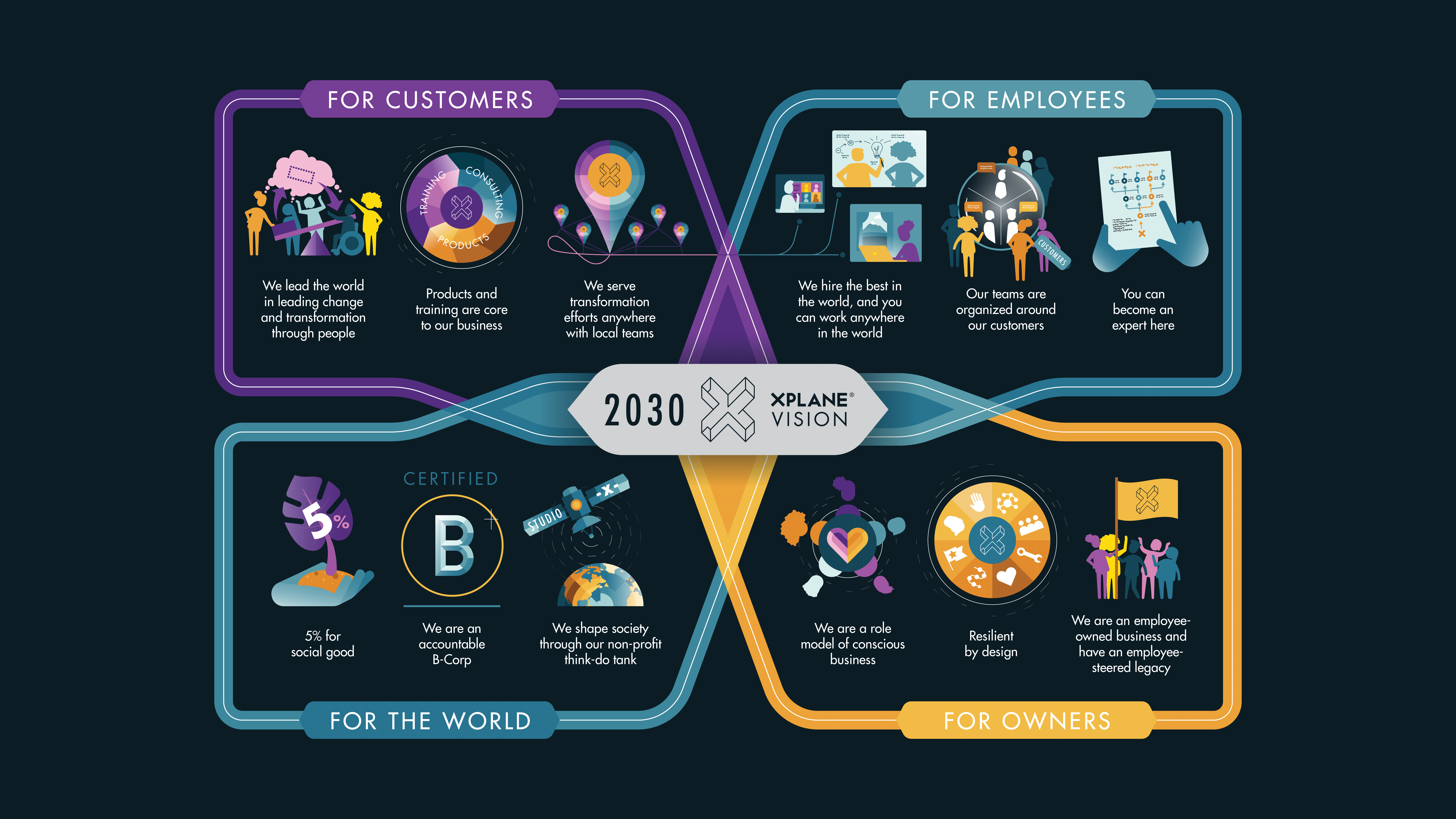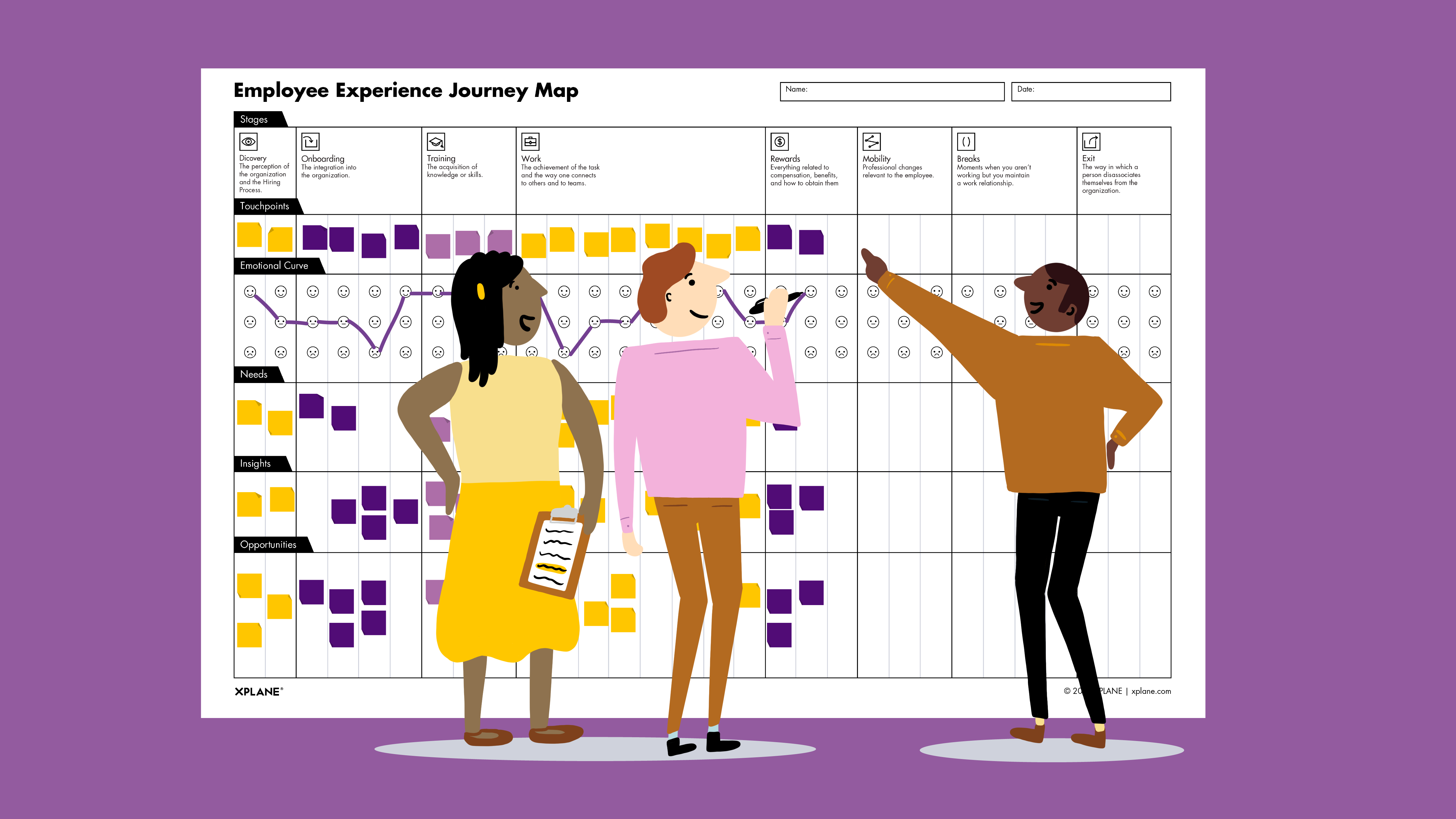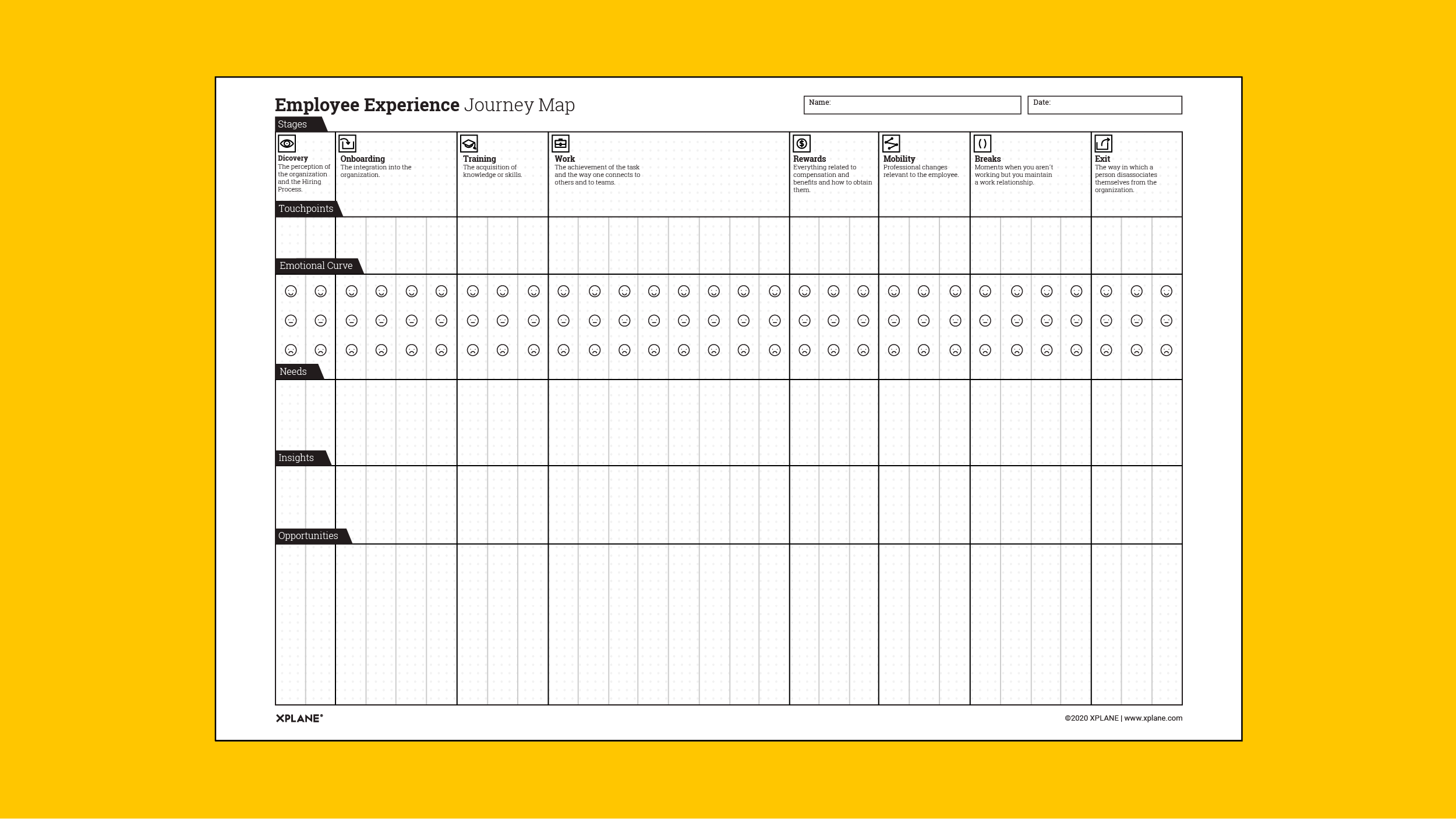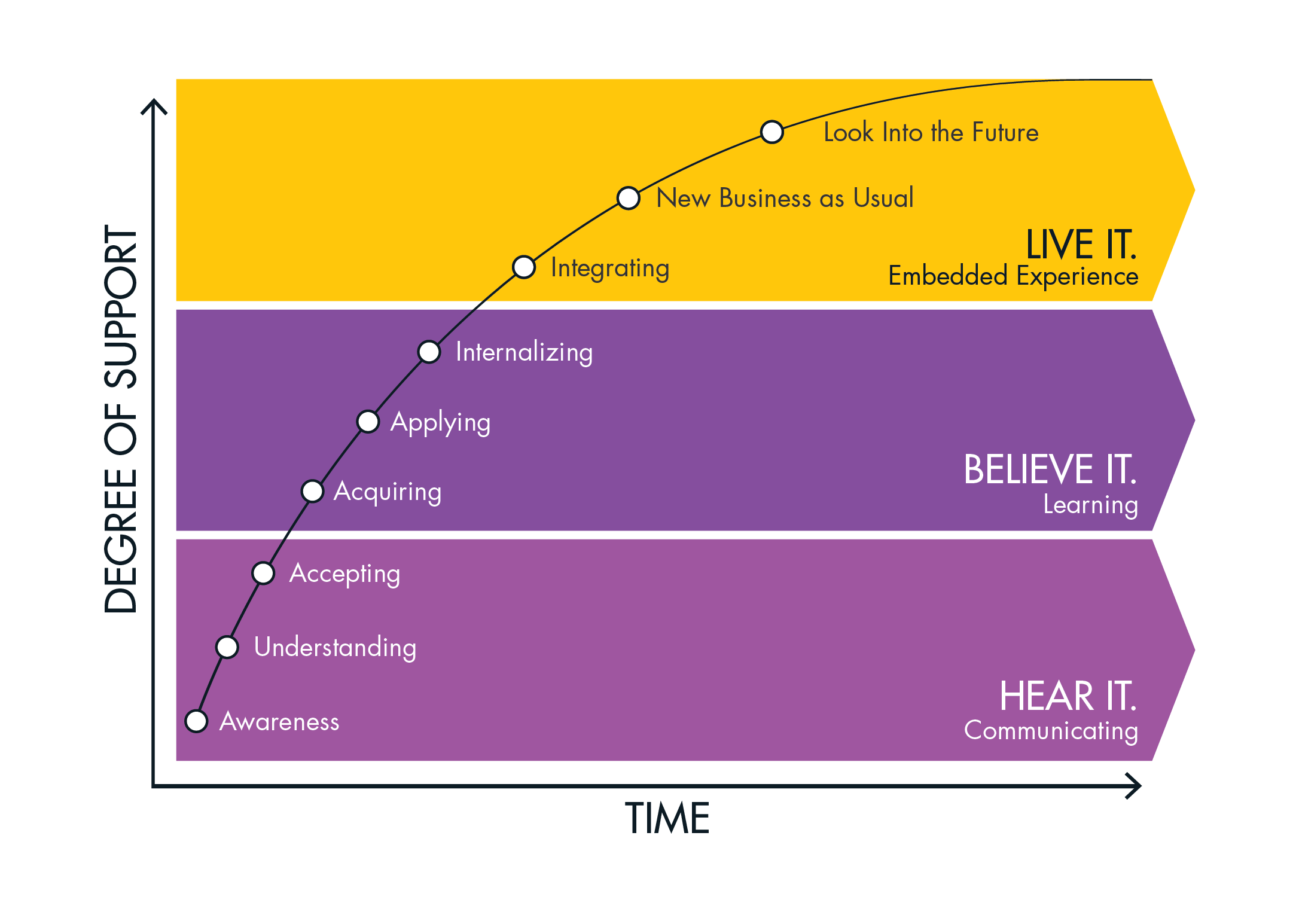As talent pools evaporate and employees leave jobs in droves for greener pastures each year, employers are keen to cultivate compelling employee experience programs to attract top talent—and keep people happy at work. Here’s a tool—and a host of tips—for creating a winning employee experience.
This blog post is a summary of a recent XPLANE webinar, Mapping the Employee Experience: Visual Tools to Improve Engagement and Retention. To watch the entire webinar, click here.
It’s time we start talking about the employee experience.
While we’ve been busy focusing on customer experience (rightly so, since customers keep us vital), we may have inadvertently pushed aside the needs of employees.
After all, employees make or break the customer experience.
When employees are unhappy, customer service can suffer. But when employees feel engaged and connected at work, customer experience improves—and with that, profitability.
Happy Employees, Productive Organizations
There are several compelling reasons to start tuning in to the employee journey:
Cost of turnover. A 2020 report by the Work Institute estimates more than one in three workers will voluntarily quit their jobs by 2023. This affects productivity. It’s also expensive for employers. Depending on the position to be filled, it can cost $4,000 or more to replace every exiting employee.
Competition for workers. There’s no longer a ready supply of workers. In 2019, the U.S. had 7+ million job openings but only 6 million unemployed. Once organizations hire and train employees, it’s critical to retain them.
Consistent productivity. Employee productivity waxes and wanes over time. New employees obviously need time to learn the ropes, but they eventually become productive. Over time, though, they may get bored—and their output dips. Organizations that help their people grow and learn are more productive overall.
Getting Away from the Daily Grind
A 2021 Global Culture Report reminds us employees don’t want to live the day-to-day grind. They want inspiring, challenging, rewarding workplace experiences.
So what does this mean? What are employees looking for?
According to the report, six principles of culture influence an employee’s decision to join, stay at, and engage in their organization:
- Purpose. Employees who know how they fit in and what their organization stands for are happier at work.
- Opportunity. Employees want the chance to learn and grow at work.
- Success. Being able to succeed at work is critical. When an employee feels like Sisyphus—doomed to push a metaphorical rock up a hill only to have to do it again every time the rock inevitably rolls down the hill—they get no sense of accomplishment, and satisfaction plummets.
- Appreciation. People need to hear, “Hey, great job.” Recognition is rewarding and motivating, and it compels them to do their best.
- Well-being. An atmosphere of empathy, inclusivity, work/life balance, and connection enable employees to be at their best.
- Leadership. Employees want leaders who mentor, coach, and inspire but who also walk the talk, leading with authenticity and integrity.
The Balanced Organization
To assess the employee journey, it’s helpful to look at work you’ve done to map the customer journey.
Remember, too, the workplace is an ecosystem consisting not only of customers and employees but also shareholders or owners, and the world at large.
These four elements need to be balanced.
If employees are unhappy, productivity suffers. Downstream, customer service takes a hit. This affects owners and the organization’s ability to do good in the world.
Not long ago, XPLANE put together a 10-year vision for where we want our company to go.
For our purposes here, the details are less important than how we aspire to balance customers, employees, the world, and our owners.

Good organizations strive to achieve this balance.
Assessing the Employee Experience
While we’ve done a lot of customer journey mapping, understanding the employee journey is a developing field.
That’s why XPLANE developed the Employee Experience Journey Map, a tool you can use to assess employee experience in your team or organization.
Think of the journey map as a springboard to initiating conversations about employee experience.
The map consists of six sections.
- Stages. The map is organized around stages of an employee’s journey, from discovery (perception of the organization and its hiring process) through exit from the organization.
- Touchpoints. These are key points of contact in the employee’s journey. A touchpoint can be anything—training, meetings (1-on-1s, all-company meetings), working with IT to get accounts and systems set up on the first day, and more.
- Emotional curve. Attempting to track the employee’s emotional curve along the journey is perhaps the most important part of the mapping exercise. Emotions help us identify employee needs, which unlock insights, and point to opportunities for improvement.
- Needs. Using data from the emotional curve, you can start to assess needs—but you’ll want to be fairly unbiased and not rush to conclusions, which people can tend to do. Be sure to understand the problem before diagnosing the solution.
- Insights. When COVID hit, we had to start working very differently. One of the things we found at XPLANE was that people felt disconnected, despite Zoom. That led to an insight: People missed the workplace kitchen, a fun place to gather and talk informally about work. Ultimately, we addressed this with creating monthly “Connect and Share” time with our Madrid office, repurposed our bi-weekly “Lunch & Learns” to explore areas of experimentation, and reimagined “kitchen time” using video conferencing tools that allowed people to spontaneously check-in with one another.
- Opportunities. Once you identify needs and insights, you can start to form ideas around concrete things to do to improve the employee experience.
Pulling it All Together
Here are a few tips for using the journey map to gather and evaluate employee experience data:
- First, don’t lock yourself in a room and do it by yourself! This is a collaborative tool, and you want to gather enough data to recognize patterns and make decisions.
- As a starting point, we recommend employees fill out their own journey map. This helps people begin to think about their experience, pinpointing needs and possibly triggering untapped insights.
- Managers might work with teams to identify common challenges and begin talking about employee experience.
- If you’re an HR professional leading a big employee experience transformation effort, you could work with your team to examine individually completed journey maps to extract common themes, challenges, and so on.
As you work through the process, you’ll discover insights and start to form ideas around what you might do to address each challenge.
Here’s what a completed Employee Experience Journey Map might look like.

Note: This worksheet was pioneered by XPLANE’s Madrid team, notes here are written in Spanish.
Making Change Happen
At XPLANE, when we’re helping make change happen within an organization, we like to frame it in terms of an activation curve.
The activation curve represents the way people often accept information. First they hear it, then they believe it, and then they start to live it.
At the outset of a change initiative, people may only be vaguely aware (or completely unaware) of something happening. They might say, “Oh, I heard this thing is going on.”
As they move up the ladder, they pass through awareness to understanding and accepting, and then to acquiring and applying. They heard the message, they get it, and they’ve moved to the believe it phase.
During this stage, they internalize the change and start to apply it in their work. Eventually, the change becomes embedded.
Final Thoughts
As you work through mapping, talking about, and improving the employee experience at your workplace, here are some tips to keep in mind:
- Start the process wherever you are.
- Be sure you understand your organization’s culture to know where you can be most effective.
- Start small. Remember you’re trying to improve the efficacy of the thing you’re trying to make happen.
- Don’t work alone. Get a lot of people involved and build momentum with quick wins.
Finally, keep us in the loop.
We’d love to hear how you’re doing on your journey toward making the employee experience in your organization the best it can be.
Additional Resources
To learn more about mapping the employee experience, we recommend the following blog posts:
- Understand Employees and Move Critical Initiatives Forward With This One Tool
- Eight Steps to Improving Employee Experience
And don’t miss our March 25 webinar, Activating Employee Experience from Within: Five Steps to Improve Employee Experience. This webinar will give you additional tips and tools for building and implementing a strong employee experience program.


